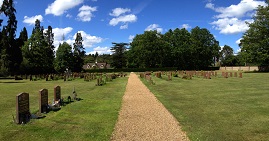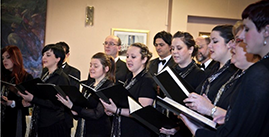The historical and cultural significance of Saint Sava
The life of St Sava has been recorded in many different forms. The first accounts were written as hagiographies – the lives of Saints – and the most famous of these was the thirteenth-century Žitije svetog Save (The Life of Saint Sava) by the monk Teodosije. Later, we find his name and events from his life circulating in stories, legends and ballads, celebrated by the ordinary people as evidence of his enduring appeal during the centuries of Ottoman domination over Serbia. In the twentieth century, biographies of his life have continued to appear, for example by the Serbian avant-garde writer Miloš Crnjanski in 1934 and by Bishop Nikolaj Velimirović in 1957. He appears as a character in novels and stories by some of Serbia's foremost authors, and we are reminded of Saint Sava as one of the first poets writing in the Serbian language in a famous anthology published in 1964. The figure of Saint Sava has flourished through the centuries to our own day.
He was born in 1175 and died in 1235. Just to put this in some kind of context for those here who are not Serbs; this period coincides with the reigns of King Richard 'the Lionheart' and his brother King John in England. It was a time of great turbulence in Europe with Crusades fought in the Holy Land, of great religious fervour and the building of grand cathedrals such as Notre Dame in Paris, and the beginning of new ideas about the responsibilities of government with the signing of the Magna Carta in 1215. The Serbian medieval state witnessed these same kinds of dramatic transformation in which Saint Sava played a prominent role. I shall try to capture something of the achievements of this man and his legacy in this short presentation.

Sava was born the youngest son of Stefan Nemanja, the first ruler to begin the process uniting the Serbs and their territories into one country. Stefan gave his son the name Rastko, and he was brought up with the expectation that he would take up his duties as befitted a member of the ruling house. However, while still a young man, he showed great interest in the church and the scriptures. Teodosije, his medieval biographer, wrote of him: 'Gentle and meek, kind to everyone, loving the poor like few before him, he had such great respect for the monastic order that even his parents felt ashamed and embarrassed when they saw such zeal and moral character in one so young, and they did not look on him as though he were their offspring, but rather as though he were truly a gift from God.' The monk's account of Sava's life is written in the conventions of a medieval hagiography which may sound today exaggerated. But his descriptions of the young man's piety and religious feeling are often repeated by others. Journeying to Mount Athos, or Sveta Gora, the Holy Mountain, he took holy orders at an Orthodox monastery where he adopted the monastic name Sava. His father sent envoys to try and persuade him to return to Serbia and continue his duties but Sava was determined on a life of prayer and meditation. In fact, instead of going back he invited his father to join him in the monastic life.
His father abdicated in 1196 and soon accepted Sava's invitation to join him. Stefan Nemanja also became a monk and took the name Simeon. Together, Sava and Simeon laid their plans to establish the Serbian monastery of Hilandar on Mount Athos. Sava went to the court of Emperor Alexius in Byzantium to ask for a charter for their religious foundation, the Emperor's daughter being the wife of Sava's brother the new ruler after the abdication of their father. Hilandar became the most renowned centre of Serbian cultural life in the Middle Ages and still stands more than 800 years later as the only religious house representing the Serbian Church on Mount Athos. On his death, Simeon was buried in the monastery. But, a few years later and in accordance with his father's wishes, Sava laid his father to rest in the monastery of Studenica in Serbia.
Sava returned to his country in 1208 where his life was to change dramatically. His two brothers, Stefan and Vukan, were fighting over the succession and the state was divided in a civil war. This was a critical period for Serbia which not only faced chaos internally but also external threats in the Balkan Peninsula after the Fourth Crusade besieged and captured Byzantium in 1204, forcing the Emperor and the Byzantine Patriarch into exile. Sava was obviously a man of many talents, among which he counted diplomatic skills. Intervening in the dispute between his brothers, he persuaded them to make peace. Holding talks with the King of Hungary and the Macedonian ruler, both of whom were poised to take advantage of Serbia's weakness, he staved off a foreign threat. The importance of Sava's place in the establishment and consolidation of the medieval Serbian kingdom cannot be exaggerated in all areas of religious, cultural, social and political life.
Sava set about a programme of building churches and monasteries, most notably the monastery of Žiča near Kraljevo in central Serbia which became the traditional place for the coronation of Serbian kings in the Middle Ages. His architectural accomplishments were accompanied by the first flowering of church art, particularly fresco painting. These achievements were based on the Byzantine models which dominated the eastern Mediterranean region at the time, but Sava also laid the foundations for a distinctly Serbian style in the visual arts. He contributed to the literary beginnings of Serbian culture with a hagiography in honour of his father Žitije svetog Simeona (The Life of Saint Simeon). He left behind a large number of other works concerning the regulation of church life and poetry inspired by his devout Christian outlook. Highly regarded both at home and abroad, he managed to persuade the Emperor and the Byzantine Patriarch to recognize the autonomy of the Serbian Orthodox Church to which he was appointed the first archbishop in 1219. By many accounts, the establishment of the national Church was his greatest single achievement. With his authority as archbishop he crowned his brother, Stefan, the first King of Serbia, assuring the state's independence. He expanded the number of priests and monks throughout Serbia, and their work helped consolidate the cultural and social coherency of the state. While his father and brother provided the beginnings of the Serbian state, Sava helped build a sense of Serbian nationhood. He bestowed on Serbia a tangible sense of its identity in the artistic and architectural legacy he created, a language in which to articulate its presence in the world, and he contributed to its independent religious and political existence. After his death in 1235 he was buried in the monastery of Mileševa and was himself canonized shortly after.
The figure of Saint Sava has continued to be celebrated. His grave at Mileševa was a site of pilgrimage for Christians from around the world. We know of the spread of a cult of Saint Sava even as far as Russia from the large number of his works found in monastic libraries there. But, of course, his memory continued to flourish in Serbia most of all even during the period of Ottoman rule. Almost 400 years after his death, an uprising against the Turks broke out in 1594. The rebels carried flags bearing the image of Saint Sava as a sign of their desire to renew Serbian independence. The commander of the Ottoman forces, Sinan-Pasha, having quashed the rebellion, set about a terrible revenge. He ordered that Sava's body be disinterred from his grave in Mileševa and brought to Belgrade. There, on the plateau of Vračar where the new church of Saint Sava is under construction, in sight of the Turkish fortress at Kalemegdan, his earthly remains were ritually burnt in a symbolic attempt to eradicate the presence of Saint Sava completely from the national narrative. Although Ottoman rule continued for another 250 years, the figure of Saint Sava was one of the key factors in keeping alive a sense of Serbian identity.

Autonomy for the Serbs in Serbia and the free development of religious life was impossible under Ottoman rule. But with the success of the Serbian Uprising led by Miloš Obrenović at the beginning of the nineteenth century an independent state was slowly formed. During this process, the memory of Saint Sava was reinforced with new churches dedicated to his name. But, it was not only in the life of the church. His name was evoked in new Serbian literature and is found in works by Branko Radičević and Vojislav Ilić among others.
In the twentieth century, similarly, Serbia's famous writers did not forget Saint Sava. These writers are not conformists celebrating traditional ideas of national identity. Radoje Domanović, a radical journalist and writer of short stories, places Saint Sava as a character in Belgrade in a satirical piece of literature. Sava is sent back to earth as the headmaster of a grammar school to help his fellow countrymen who are not coping very well with the rapid social transformation as Serbia enters the modern age. His wisdom and piety contrast with the defects and shortcomings of life at the beginning of the twentieth century. In the 1930s, the most avant-garde of authors, Miloš Crnjanski, a Serbian James Joyce, put his linguistic experiments on one side in order to write a biography of Sava for the modern reading public. The poet Miodrag Pavlović published a ground-breaking anthology of Serbian poetry in 1964. Pavlović intended that his anthology emphasize a contemplative and spiritual expression in Serbian literature down the ages which he opens with three poems by Saint Sava. More recently, in 1997, the postmodern novelist Goran Petrović begins his novel set in medieval Serbia, Opsada crkve svetog Spasa (The Siege of the Church of Saint the Saviour) with a story about Sava's building of the monastery of Žiča. Down to today, Saint Sava is associated most of all with culture and education, and his figure in this literature represents that association of human values confronting the challenges of the transience of the modern world.
It is easy to see in Sava's accomplishments a political and rational will. This is our twenty-first century desire to explain the world in terms of loss and gain which have a material balance. But we must not forget that Sava lived in a different age in which religious devotion and faith were central to the order of the world. Sava's work for an independent Serbian Church was not just for a political goal and I shall close with the words of Bishop Nikolaj on this event: 'When he organized the Serbian National Church, it was not from the idea of exciting chauvinism among Serbs and much less of resuscitating their pagan tribal religion. He wanted, only through the nationally organized church, to make his people a worthy member of the universal orthodox family of Christ. He himself was permeated with the spirit of ecumenical Christianity. As such, he felt at home in every Orthodox community of every race and language.'
Dr David Norris
Department of Russian and Slavonic Studies
University of Nottingham






